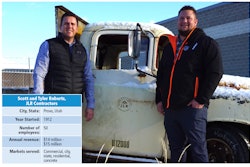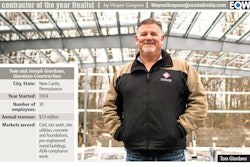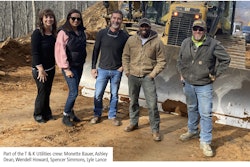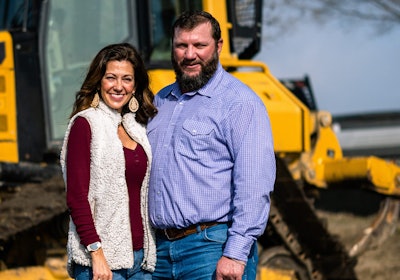
Fred Stephenson didn’t just go to work. He chased it, digging up and pushing earth across a wide swath of the American West.
As he blazed that trail from Wyoming to Montana to Texas to Colorado, his boy was behind him the whole way. Watching his father’s dedication to hard work, attention to detail and providing for his family, Clint Stephenson was raised on construction, but also on the importance of creating your own opportunities instead of waiting on them to come to you.
“I knew I wanted my own business a year or less after I graduated college in 1993,” says Stephenson, co-owner of CLS Excavation. He played football at Texas Christian University and after school moved to Colorado to work for his father. During college he met his wife and future business partner, Amber. “I went into this because I had a wife. She was counting on me, and I have to take care of her.
“This was what I knew how to do.”
A long line of earthmovers
Stephenson’s people have been moving dirt a long time. His grandfather John D. Wright started in Titus County, Texas, with mule-drawn scrapers before he bought what is thought to be the first bulldozer in that piece of country, between Dallas and Texarkana. The machine was such a new concept that Wright had to go clear across Texas before he found someone to run it.
With the momentum of that lineage behind him, Stephenson got an early introduction to equipment operation.
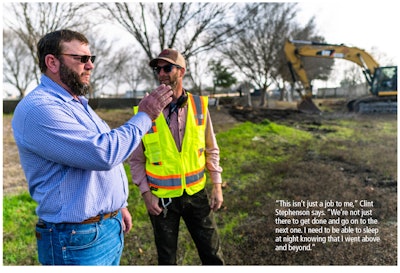
By the time he was in ninth grade, he was running D8s, a 988 loader and a 633 paddle wheel scraper.
Just as his father, Fred, had worked for his father in-law, Stephenson spent much of his early years working alongside his father. But in 1996, he and Amber decided to strike out on their own. They packed up everything they owned and split it between his dump truck and her Geo Tracker and moved from Mt. Pleasant, Texas, to Austin. It didn’t take long for the Stephensons to find their first consistent work.
“We moved into an apartment complex that was still under construction, and I asked who was hauling their dirt,” he recalls. “I offered to cut that price by $5 a load and asked if they’d give me the job.”
Stephenson ran that dump truck all over Austin for about a year and a half before he bought a 416 Cat backhoe from his brother. “I had made as much money as I could from the dump truck, and eventually the backhoe started doing so much more that I had to sub out the trucking work I was doing,” he says.
In 1998, following the purchase of a Cat D5H dozer, Stephenson took out an ad in the yellow pages and landed his first commercial job. From there, CLS amassed more machines and more work.
In 2019, the company brought in $3 million and is anticipating $4 million to $5 million in revenue for 2020.
Buying used
The CLS equipment fleet is 100 percent owned, Stephenson said, though the company occasionally leases. It buys used machines and does most of its own maintenance.
“We buy good quality, low-hour machines. It costs me less to get into it, but I still can do the same amount of work as a brand new one,” Stephenson says. “And we treat all of our equipment like it provides for our families.”
Stephenson says repairability is becoming a big concern. “Some of this brand-new stuff…they’re not making it end-user friendly as far as being able to work on it,” he says. “Plus, the dealerships are two to four weeks backed up in getting out to us.”
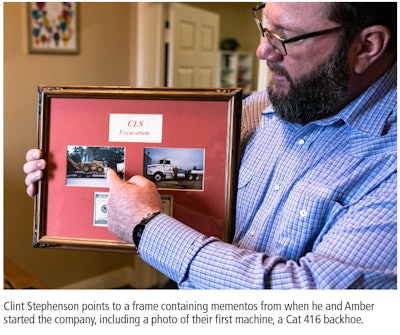
“When we got going with GPS, that was such a game-changer for us,” Stephenson says. “Hardly anybody had it at that point and it made me so much more efficient, and I could do larger jobs with fewer pieces and fewer people. For a while there, if I wanted a job, I could get it.”
Today, CLS uses GPS on its excavators, motor graders and dozers.
Playing the long game
Stephenson says CLS performs no public work. “Everybody on the commercial side is there to make money. Nobody has an agenda,” he says.
The biggest key to the company’s success has been long-term planning, Stephenson says. For instance, when the company was starting out, he and Amber decided they would be known for paying their bills. “We paid everything off and stayed cash poor, including our first house,” Stephenson says.
That strategy continues today. “Ninety-five percent of the time, we pay before we get paid ourselves. Just because you have money in the bank doesn’t mean you’re rich. You have to be disciplined with your money because it leaves just as fast as it comes in.”
While Stephenson roves the company’s jobsites and manages operations, Amber handles just about everything else from the office. Among other duties, she oversees the payroll, accounts receivable and payable, equipment financing and manages the company’s website. “We know what we started with, and we have relied on each other from the beginning,” he says. “We talk, not just about work, [and] I trust her 100 percent with the money.”
He says Amber’s strong attention to detail, organization and honesty when it comes to making big business decisions tend to balance out his weaknesses. “The big decisions take months and years to make. I come to her with ideas and plans, and she helps poke holes into it, which is needed,” he says.
In addition to the work CLS does, the Stephensons invest in land development. They have a water business at a nearby oilfield, and they own a storage facility. “The excavation is what I call my ‘real job,’” Stephenson says. “The other businesses are my side jobs, and that’s where you help keep things coming in when your dirt work gets slow.
“You need to have as many revenue streams as you can. It helps keep the ship afloat.”
“I don’t want junk”
Stephenson says his attention to detail and the pride he and his employees take in their work give the company a competitive edge. “This isn’t just a job to me. We’re not just there to get done and go on to the next one,” he says. “I need to be able to sleep at night knowing that I went above and beyond.
“Plus, I know if it’s good enough for me, it’s good enough for my client. Because I have high standards, I don’t want junk.”
“He looks out for the customer,” says Kent Burkhart of the Kent Burkhart Company. “Clint is very involved with everything going on on the site. If he can make some money and save you some money, everyone wins, and he doesn’t get greedy.”
“Everything he’s done he leaves a better mark on the area than when he first showed up,” says Jon Brangan of Copper Ridge Investments. “That’s big for a smaller community. That goes to show his overall character. He cares about the people and the town he lives in.”
Though they’re always on the lookout for potential investment opportunities, the Stephensons say their primary focus with CLS now is landing bigger jobs in the markets they serve. As with so many other contractors, the primary challenge is finding quality laborers and equipment operators.
“It’s gotten even worse now because everybody’s busy,” Stephenson says. “Everybody wants to be paid top dollar, but not many of them can show up five days in a row.”
The Contractor of the Year program has been sponsored by Caterpillar for 21 years. For more information, click here.

